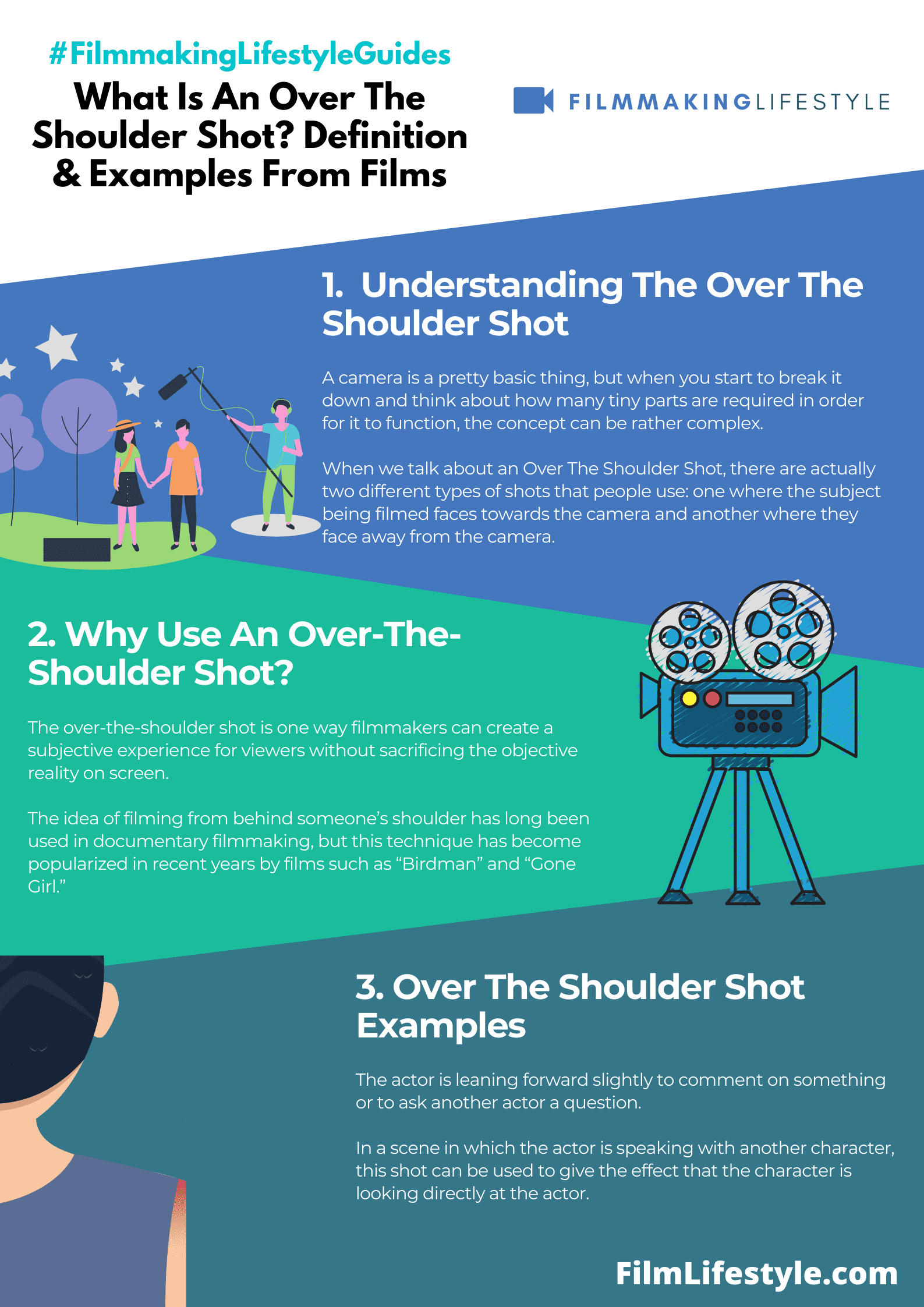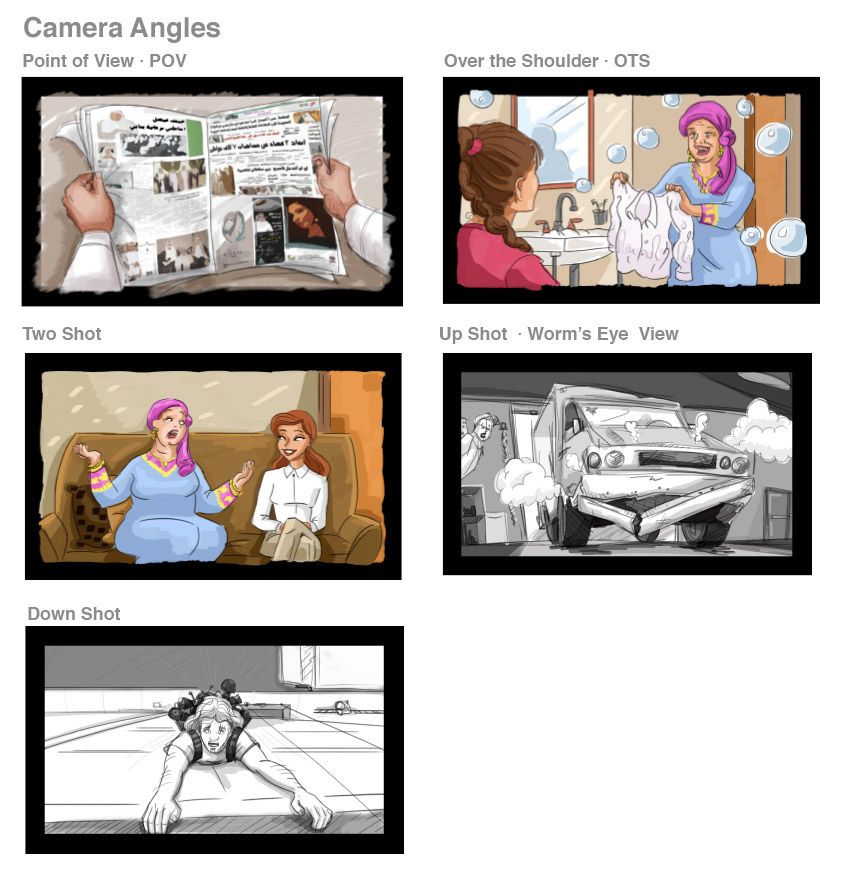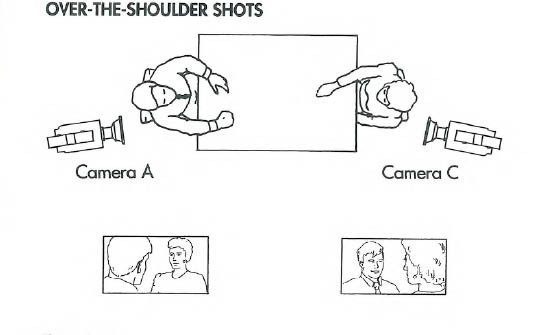The over-the-shoulder camera shot is an unusual camera angle used mainly in television and film, in which the camera is placed directly above the head of an object and often behind the subject’s back.
This shot is used mainly to present close-up, conversational back and forth dialogue between two subjects.
Typically, this shot occurs when the camera shows someone in the front yard or gate of a house as they are talking with another individual.
In most cases, the person filming will lean over and slightly away from the object while talking to the other individual.
However, some films may use this shot where the subject is actually leaning in the opposite direction from the camera.
OVER THE shoulder shot
What Is An Over The Shoulder Shot?
An over-the-shoulder shot is a type of camera angle where the person in front of the camera is shown from behind, with their body blocking most or all of what’s being filmed. Often, literally, over their shoulder.
The term over-the-shoulder can also refer to footage that shows someone else’s hands typing on their computer keyboard.
This kind of filming technique often sees use in documentary-style productions and movies. It is intended to give viewers an intimate and personal view of the lives or thoughts of those who are being filmed.
In the world of filmmaking, the over the shoulder shot is a staple that we’ve all seen, whether we’re conscious of it or not.
It’s that intimate frame capturing a conversation, with one character’s shoulder and back of the head in the foreground, and the other character’s face in focus.
This technique isn’t just about showing who’s talking; it’s a powerful tool for creating connection and perspective.
We’ll jump into how this shot pulls viewers into the narrative, fostering a sense of involvement in the on-screen dialogue.
Stick with us as we explore the nuances of the over the shoulder shot and why it’s such an essential part of cinematic storytelling.
What Is An Over The Shoulder Shot?
Over the shoulder shots are a dynamic tool in our visual storytelling arsenal.
They position the audience right in the middle of a dialogue, fostering an intimate connection between the characters and the viewer.
In essence, this technique involves the camera filming over the shoulder of one character, focusing on another.
The foreground usually includes the back of one character’s head and a portion of their shoulder, hence the name.
Employing over the shoulder shots allows viewers to engage with the emotional nuances of a conversation.
It’s a way to subtly show who has the upper hand in a scene or to draw attention to a character’s reactions.
Envision a tense exchange in The Godfather – by alternating over the shoulder views, we feel the power dynamics at play.
We choose specific variations of the over the shoulder shot to serve different narrative purposes:
- Framing – Adjusting the size of the shoulder in frame can intensify or relax the scene’s tension,
- Depth – A shallow focus can isolate characters, while a deeper focus can reveal context or foreshadowing,
- Angle – Eye-level shots create a sense of equality, whereas high or low angles can signify power disparities.
These components come together to deliver a message without a single line of dialogue.
That’s the power of the over the shoulder shot.
It’s no surprise that it’s one of the most prevalent visual techniques across a range of genres and styles.
Whether in blockbuster movies, Indie Films, or even serialized television dramas, the over the shoulder shot remains a classic, trusted method to involve the audience in the film’s emotional journey.
The Purpose Of Using Over The Shoulder Shots
When we craft a narrative, each shot carries tremendous weight.
Over the shoulder shots are no exception to this rule, and they serve several key purposes in filmmaking:
- Establishing connection – These shots put us in the proverbial shoes of one character, while still grounding us in the presence of another.
- Conveying conversation dynamics – The subtle interplay of visual cues can indicate dominance, tension, or camaraderie, amplifying the spoken dialogue.
In the language of cinema, over the shoulder shots are a staple for dialogue scenes.
They offer a unique visual composition that we recognize as both natural and engaging.
- Enhancing audience immersion – By mirroring real-life interactions, the shot pulls viewers deeper into the scene.
- Maintaining continuity – It helps us to follow the flow of conversation without disorienting cuts or jumps.
By altering the focal length, camera position, and depth of field, we can use over the shoulder shots to express a wide range of emotions and narrative twists.
- Depicting intimacy – A shallow depth of field can blur the background, focusing on the emotional exchange.
- Signifying isolation – A deep focus can make characters appear distant or detached, even when they’re in close proximity.
When we look at classics like The Godfather or contemporary hits like Breaking Bad, over the shoulder shots are wielded with precision to draw us into the characters’ worlds.
In these instances, they’re more than just a technical choice; they’re storytellers in their own right.
It’s through these thoughtful compositions that we as filmmakers can sculpt the audience’s experience, guiding their attention and emotions with every frame.

https://youtube.com/watch?v=HmVV8-qMNno
Capturing Connection And Perspective
In the vast vocabulary of visual storytelling, we understand that the over the shoulder shot stands out for its ability to capture connection.
It’s through these shots that filmmakers can bridge the emotional gap between characters and the audience.
There’s an inherent intimacy in looking over a character’s shoulder, as if we’re right there beside them, enveloped in the narrative fabric of movies like The Godfather or The Shawshank Redemption.
Positioning the camera over the shoulder creates a unique perspective and can subtly influence our perception of the on-screen relationships.
This technique can be pivotal in scenes where the power dynamics are crucial, with changes in the height or angle of the camera expressing dominance or vulnerability.
Use of shallow focus further draws us to the characters’ expressions, reinforcing their emotions as our own.
To illustrate just how these shots work, let’s consider elements that enhance their impact:
- Depth of field – establishes focus and guides our attention,
- Eye-line match – fosters a sense of real-time engagement,
- Camera movement – adds dynamism or tension to the conversation.
Manipulating these elements ensures the over the shoulder shot remains an indispensable tool in our cinematic arsenal.
For example, by tweaking the depth of field, a filmmaker can make us feel the isolation or connectivity of a character within a wider scene.
Or, by carefully matching eye-lines, we uphold the illusion of a seamless dialog that transcends the screen and enters our space.
It’s not just the subtleties of camerawork that make these shots so powerful.
It’s also about the conscious decisions behind each frame that transport us into the story world.
With every calculated move of the camera, we’re not just observers but participants in the unfolding drama, testament to the undeniable power of the over the shoulder shot.
Techniques And Compositions For Over The Shoulder Shots
When we structure an over the shoulder shot, we’re intricately weaving the visual story.
Our first concern is the composition – where will the subject and speaker be placed within the frame?
The rule of thirds is our classic guide, positioning our characters in a way that’s both aesthetically pleasing and narratively effective.
The depth of field is another critical element we adjust to elicit emotion.
A shallow depth highlights a character’s face, isolating them from the background and drawing the viewer’s eye to the emotional core of the scene.
Conversely, a wider depth can reveal more of the setting, placing the conversation in a richer context.
We think about the balance between characters.
Who holds the power in the dialogue?
Elevating one character’s eye-line above the other suggests dominance, while an equal eye-line implies a more balanced exchange.
These subtle cues are pivotal in shaping our audience’s understanding of character dynamics.
Camera movement within an over the shoulder shot creates dynamic storytelling.
A slow push-in heightens tension, while a pull-away can signify detachment.
Each movement is meticulously planned to complement the dialogue rhythm and enhance the viewer’s emotional journey.
Here are elements we consider integral to crafting an over the shoulder shot:
- Rule of thirds for engaging composition,
- Adjusted depth of field for emotional focus,
- Dominance and submission expressed through character positioning,
- Purposeful camera movement to match the dialogue’s pacing.
Our choice of lens and lighting setup can make or break the scene.
A longer lens compresses space, making the background less distracting and focusing more on the interaction.
Strategic lighting can separate our characters from the environment or draw them into it, depending on the desired effect.
Film titles like The Godfather Use these techniques masterfully, striking a delicate balance between connection and individuality, power and vulnerability.
Through refined camera work and thoughtful composition, we create not just a shot, but a revelation.
Tips For Shooting Over The Shoulder Shots
When we’re tasked with shooting over the shoulder shots, it’s crucial to consider the intricate dynamics between the camera, the subject, and the background.
It’s not just about framing the shot – it’s about the interplay of elements that capture the viewer’s attention and drive the narrative forward.
First and foremost, it’s essential to focus on the eyes of the character who’s not facing the camera.
Their reaction often holds the emotional weight of the scene, so getting the focus right is non-negotiable.
Speaking of focus, using auto-focus can sometimes lead to unexpected shifts during a take, which is why manual focus is usually our go-to choice for maintaining consistency throughout the shot.
The distance between the camera and the subject can drastically alter the feel of the shot.
For a more intimate feel, we get the camera close to the person over whose shoulder we’re shooting.
In contrast, a wider shot can establish the environment and the relationship between characters without losing the personal connection to the dialogue.
Here are a few essential components to remember:
- Eye-line match is critical for establishing a coherent spatial relationship.
- The rule of thirds helps in composing visually appealing frames.
- Adequate headroom ensures the shot doesn’t feel cramped.
Lighting plays a pivotal role as it does in many aspects of filmmaking.
Our aim is always to light the scene in a way that feels natural and complements the mood we’re trying to evoke.

Soft light is often used to avoid harsh shadows that can distract from the critical elements within the frame.
It’s also helpful to consider the benefits of camera stabilization tools for these shots, especially when dealing with longer takes or moments requiring subtle movement.
A well-balanced shoulder rig or a dependable tripod can make all the difference in the smooth execution of an over the shoulder shot.
These tools not only steady the frame but also give us the flexibility to maneuver the camera and adjust the composition on the fly without compromising the visual integrity of the scene.
Selecting the right lens is another key factor.
A longer lens can compress the space and focus more on the interaction, while a wider lens may introduce more of the surrounding context within the scene.
Each choice tells a different story, and it’s up to us to decide which lens best suits the moment we’re capturing.
Over The Shoulder Shot In Filmmaking – Wrap Up
We’ve explored the nuances of the over the shoulder shot and its profound influence on cinematic storytelling.
Mastering this technique requires attention to detail and an understanding of visual language.
By focusing on the eyes, maintaining appropriate distance and employing effective lighting, filmmakers can create powerful scenes that resonate with audiences.
Remember, it’s not just about the technical aspects but also the emotional connection these shots foster.
Armed with these insights, we’re confident you’ll elevate your filmmaking craft and captivate viewers like never before.
Frequently Asked Questions
What Is An Over The Shoulder Shot In Filmmaking?
An over the shoulder shot frames the back of one character’s shoulder and head while focusing on another character or subject, helping to create an intimate and engaging scene by showing perspective and depth.
Why Is Composition Important In Over The Shoulder Shots?
Composition in over the shoulder shots is crucial as it determines the spatial relationship between characters, directs the audience’s attention, and influences the emotional tone of the conversation or scene.
How Does Depth Of Field Affect Over The Shoulder Shots?
Depth of field can either isolate the foreground subject by blurring the background or keep both the subject and the background in focus, thereby influencing the audience’s emotional connection to the characters and their understanding of the scene.

What Role Does Character Positioning Play In These Shots?
Character positioning in over the shoulder shots establishes the dynamic between characters and can imply intimacy, conflict, or power relations, thereby contributing to the storytelling.

How Can Camera Movement Enhance Storytelling In These Shots?
Camera movement, whether it’s a pan, tilt, or tracking shot, can add emphasis to a character’s actions or reactions, reinforce narrative points, or build tension in an over the shoulder shot.
Why Is Lens Choice Significant When Shooting Over The Shoulder?
Lens choice affects the shot’s field of view, depth of field, and the level of background compression, all of which shape the audience’s perspective and can dramatically alter the emotional impact of the scene.

How Does “the Godfather” Utilize Over The Shoulder Shots Effectively?
“The Godfather” masterfully uses over the shoulder shots to establish power dynamics, build tension, and create an intimate portrayal of the characters, making it a prime example of the technique’s effectiveness.
What Are Some Tips For Shooting Effective Over The Shoulder Shots?
To shoot effective over the shoulder shots: focus on the character’s eyes, maintain an appropriate distance between the camera and the subject, use lighting that compliments the mood, employ camera stabilization for a smooth presentation, and select the right lens for the desired effect.
Matt Crawford
Related posts
8 Comments
Leave a Reply Cancel reply
This site uses Akismet to reduce spam. Learn how your comment data is processed.



This is a good illustrational video. I recommend it.
Thanks. Appreciate it.
I love over the shoulder shots in films! They add such a unique and interesting element to a film. They can be used for a variety of purposes, such as establishing character, adding suspense, or just to make the scene more interesting.
Thanks for the regular comments, Jake.
I love over the shoulder shots in films! They add such a unique and interesting element to a film. They can be used for a variety of purposes, such as establishing character, adding suspense, or just to make the scene more interesting.
Thanks.
Great post! I totally agree that over the shoulder shots can add depth and context to a scene. They’re especially useful when the scene is complex or needs to be conveyed quickly. Thanks for sharing these great examples from films!
Thanks!